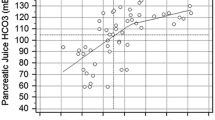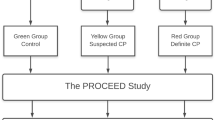Abstract
Purpose
Secretin-stimulated magnetic resonance imaging (s-MRI) and pancreatic diffusion weighted imaging (DWI) are novel non-invasive imaging techniques for assessment of exocrine pancreatic insufficiency (EPI). The aim was to validate s-MRI assessed pancreatic secreted volume using novel semi-automatic quantification software, and to assess the ability of s-MRI with DWI to diagnose EPI in patients with cystic fibrosis (CF).
Methods
s-MRI and DWI was performed in 19 patients with CF (median age 21 years; range 16–56; eight men) and in 10 healthy controls (HC) (median age 46 years; range 20–65; four men). Sequential coronal T2-weighted images covering the duodenum and small bowel and axial DWI were acquired before and 1, 5, 9, and 13 min after secretin stimulation. A short endoscopic secretin test was used as reference method for EPI.
Results
CF patients with EPI had lower apparent diffusion coefficient before secretin in the pancreatic head (P < 0.001) and lower secreted bowel fluid volumes (P = 0.035) compared to HC and CF patients without EPI. ROC curve analyses identified that secreted fluid volume after 13 min yielded the highest diagnostic accuracy for diagnosing EPI (AUC 0.93; 95% CI [0.80–1.00]).
Conclusion
Pancreatic s-MRI is useful for the assessment of exocrine pancreatic function with high diagnostic accuracy for the diagnosis of EPI in CF.




Similar content being viewed by others
Abbreviations
- CF:
-
Cystic fibrosis
- HC:
-
Healthy controls
- EPI:
-
Exocrine pancreatic insufficiency
- s-MRI:
-
Secretin-stimulated magnetic resonance imaging
- DWI:
-
Diffusion weighted imaging
- ADC:
-
Apparent diffusion coefficient
References
Dominguez-Munoz JE (2011) Pancreatic exocrine insufficiency: diagnosis and treatment. J Gastroenterol Hepatol 26(Suppl 2):12–16
Lindkvist B, Phillips ME, Dominguez-Munoz JE (2015) Clinical, anthropometric and laboratory nutritional markers of pancreatic exocrine insufficiency: prevalence and diagnostic use. Pancreatology 15:589–597
Stevens T, Parsi MA (2011) Update on endoscopic pancreatic function testing. World J Gastroenterol 17:3957–3961
Conwell DL, Lee LS, Yadav D, et al. (2014) American Pancreatic Association Practice Guidelines in Chronic Pancreatitis: evidence-based report on diagnostic guidelines. Pancreas 43:1143–1162
Stevens T, Conwell DL, Zuccaro GJ, et al. (2008) A prospective crossover study comparing secretin-stimulated endoscopic and Dreiling tube pancreatic function testing in patients evaluated for chronic pancreatitis. Gastrointest Endosc 67:458–466
Erchinger F, Engjom T, Tjora E, et al. (2013) Quantification of pancreatic function using a clinically feasible short endoscopic secretin test. Pancreas 42:1101–1106
Gillams A, Pereira S, Webster G, Lees W (2008) Correlation of MRCP quantification (MRCPQ) with conventional non-invasive pancreatic exocrine function tests. Abdom Imaging 33:469–473
Couper RT, Corey M, Moore DJ, et al. (1992) Decline of exocrine pancreatic function in cystic fibrosis patients with pancreatic sufficiency. Pediatr Res 32:179–182
Walkowiak J, Nousia-Arvanitakis S, Agguridaki C, et al. (2003) Longitudinal follow-up of exocrine pancreatic function in pancreatic sufficient cystic fibrosis patients using the fecal elastase-1 test. J Pediatr Gastroenterol Nutr 36:474–478
Madzak A, Olesen SS, Wathle GK, et al. (2016) Secretin-stimulated magnetic resonance imaging assessment of the benign pancreatic disorders: systematic review and proposal for a standardized protocol. Pancreas 45:1092–1103
Matos C, Metens T, Devière J, et al. (1997) Pancreatic duct: morphologic and functional evaluation with dynamic MR pancreatography after secretin stimulation. Radiology 203:435–441
Punwani S, Gillams AR, Lees WR (2003) Non-invasive quantification of pancreatic exocrine function using secretin-stimulated MRCP. Eur Radiol 13:273–276
Wathle GK, Tjora E, Ersland L, et al. (2014) Assessment of exocrine pancreatic function by secretin-stimulated magnetic resonance cholangiopancreaticography and diffusion-weighted imaging in healthy controls. J Magn Reson Imaging 39:448–454
Bali MA, Sztantics A, Metens T, et al. (2005) Quantification of pancreatic exocrine function with secretin-enhanced magnetic resonance cholangiopancreatography: normal values and short-term effects of pancreatic duct drainage procedures in chronic pancreatitis. Initial results. Eur Radiol 15:2110–2121
Frøkjær JB, Olesen SS, Drewes AM (2013) Fibrosis, atrophy, and ductal pathology in chronic pancreatitis are associated with pancreatic function but independent of symptoms. Pancreas 42:1182–1187
O’Sullivan BP, Freedman SD (2009) Cystic fibrosis. Lancet (London, England) 373:1891–1904. doi:10.1016/S0140-6736(09)60327-5
Kopelman H, Durie P, Gaskin K, Weizman Z, Forstner G (1985) Pancreatic fluid secretion and protein hyperconcentration in cystic fibrosis. N Engl J Med 312:329–334
Jonczyk-Potoczna K, Nowak JK, Madry E, et al. (2016) Secretin-enhanced magnetic resonance cholangio-pancreatography in pancreatic insufficient and pancreatic sufficient cystic fibrosis patients. J Gastrointest Liver Dis 25:57–62
Jonczyk-Potoczna K, Nowak JK, Madry E, et al. (2016) Smaller width of the pancreatic duct during secretin-enhanced magnetic resonance cholangiopancreatography in pancreatic-sufficient cystic fibrosis patients. Pancreas 45:1175–1178
Tjora E, Wathle G, Erchinger F, et al. (2013) Exocrine pancreatic function in hepatocyte nuclear factor 1β-maturity-onset diabetes of the young (HNF1B-MODY) is only moderately reduced: compensatory hypersecretion from a hypoplastic pancreas. Diabet Med 30:946–955
Engjom T, Erchinger F, Laerum BN, et al. (2015) Diagnostic accuracy of a short endoscopic secretin test in patients with cystic fibrosis. Pancreas 44:1266–1272
Farrell PM, Rosenstein BJ, White TB, et al. (2008) Guidelines for diagnosis of cystic fibrosis in newborns through older adults: Cystic Fibrosis Foundation consensus report. J Pediatr 153:S4–S14
Tjora E, Wathle GK, Engjom T, et al. (2013) Severe pancreatic dysfunction but compensated nutritional status in monogenic pancreatic disease caused by carboxyl-ester lipase mutations. Pancreas 42:1078–1084
Walkowiak J, Cichy WK, Herzig KH (1999) Comparison of fecal elastase-1 determination with the secretin-cholecystokinin test in patients with cystic fibrosis. Scand J Gastroenterol 34:202–207
Sandberg TH, Nilsson M, Poulsen JL, et al. (2015) A novel semi-automatic segmentation method for volumetric assessment of the colon based on magnetic resonance imaging. Abdom Imaging 40:2232–2241
Mensel B, Messner P, Mayerle J, et al. (2014) Secretin-stimulated MRCP in volunteers: assessment of safety, duct visualization, and pancreatic exocrine function. AJR Am J Roentgenol 202:102–108
Gibson-Corley KN, Meyerholz DK, Engelhardt JF (2016) Pancreatic pathophysiology in cystic fibrosis. J Pathol 238:311–320
Lavelle LP, McEvoy SH, Ni Mhurchu E, et al. (2015) Cystic fibrosis below the diaphragm: abdominal findings in adult patients. Radiographics 35:680–695
Schoennagel BP, Habermann CR, Roesch M, et al. (2011) Diffusion-weighted imaging of the healthy pancreas: apparent diffusion coefficient values of the normal head, body, and tail calculated from different sets of b-values. J Magn Reson Imaging 34:861–865
Akisik MF, Aisen AM, Jennings SG, et al. (2009) Assessment of chronic pancreatitis: utility of diffusion-weighted MR imaging with secretin enhancement. Radiology 250:103–109
Patient Registry (2013) Cystic Fibrosis Foundation Patient Registry Annual Data Report, pp. 1–15.
Lanng S, Thorsteinsson B, Erichsen G, Nerup J, Koch C (1991) Glucose tolerance in cystic fibrosis. Arch Dis Child 66:612–616
Borowitz D, Baker SS, Duffy L, et al. (2004) Use of fecal elastase-1 to classify pancreatic status in patients with cystic fibrosis. J Pediatr 145:322–326
Walkowiak J, Nousia-Arvanitakis S, Cade A, et al. (2002) Fecal elastase-1 cut-off levels in the assessment of exocrine pancreatic function in cystic fibrosis. J Cyst Fibros 1:260–264
Author information
Authors and Affiliations
Corresponding author
Ethics declarations
Funding
No funding was received for this study.
Conflict of interest
The authors declare that they have no conflict of interest.
Ethical approval
All procedures performed in studies involving human participants were in accordance with the ethical standards of the institutional and/or national research committee and with the 1964 Helsinki declaration and its later amendments or comparable ethical standards.
Informed consent
Informed consent was obtained from all individual participants included in the study.
Rights and permissions
About this article
Cite this article
Madzak, A., Engjom, T., Wathle, G.K. et al. Secretin-stimulated MRI assessment of exocrine pancreatic function in patients with cystic fibrosis and healthy controls. Abdom Radiol 42, 890–899 (2017). https://doi.org/10.1007/s00261-016-0972-8
Published:
Issue Date:
DOI: https://doi.org/10.1007/s00261-016-0972-8




